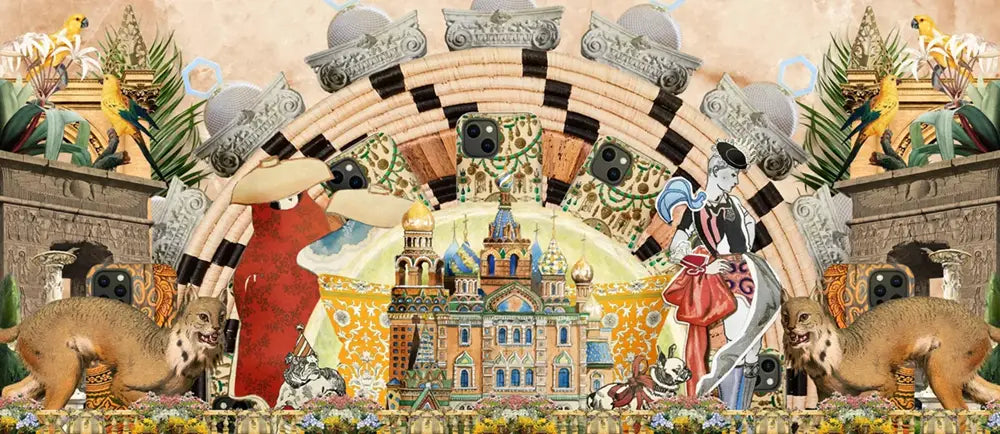Mythic Sicily as Queer Threshold
Even before the railway spilled its lacquered travelers down the boot of Italy, before Wagner borrowed Taormina’s sea-laced air to score his swan songs, Sicily shimmered not as place but as proposition. It was myth cut from basalt and citrus pith — a southern mirage seen through northern frost. On the eastern edge, beneath the mouth of Etna and her volcanic sighs, a town folded from Greek shadow and Byzantine rubble became a queer portal. Taormina. A cliff-perched dream-world whose ruins still rehearse Homeric dramas in sun-washed silence.
In the fevered cartography of 19th-century longing, Taormina emerged not as refuge but as erotic hypothesis — a place where Northern men fleeing bridle and frost might re-invoke the Hellenes beneath bougainvillea. It was Goethe who passed through first, scribbling Taormina into his grand tour as a lyric footnote. But by the cusp of the 20th century, it was a German of different ink who re-scripted the town entirely: Baron Wilhelm von Gloeden, the tubercular Prussian aristocrat with lungs full of ruin and eyes trained on antiquity.
He arrived in 1878, more invalid than icon, crumpling under Baltic dampness and the weight of a family title. But Sicily, he found, was not simply warm — it was ecstatic. It peeled back the European veil, revealed a Mediterranean pulse that made sodomy feel sacramental. By the time the century turned, Gloeden had not only healed; he had constructed a homoerotic Arcadia from light, limestone, and the bodies of young men.
The queer salon he summoned into being bore none of the Gothic hush of Paris or Weimar. His Taormina was bacchanalian and brazen — a theater without curtains, where camera lenses replaced frescoes, and shepherd boys stood in for satyrs.
No one came merely to admire ruins. They came to enter them, stage themselves inside them, and sweat myth from their brows. To be photographed by the Baron was to be subsumed — part statue, part sex, part souvenir. One British visitor called it “standing inside a Sapphic whisper,” though he meant Eros, not Lesbos.
But myth doesn’t reside in architecture alone. Gloeden’s genius was to flood it with flesh. He did not document Sicily — he rewrote it. And in doing so, he carved from a fading village a shrine to queer becoming, decades before the word would name itself.
Key Takeaways
-
Antiquity was never still stone. In Gloeden’s Taormina, it breathed through adolescent bodies, flickering between desire and disguise, myth and labor, sun and shadow.
-
Gloeden’s lens didn’t just aestheticize the male nude; it weaponized Hellenism to carve a loophole through European homophobia, slipping queerness past censors beneath olive branches and laurel crowns.
-
Taormina was was constructed, frame by frame, as a queer sanctuary masquerading as neoclassical pilgrimage. Where every foreign guest staged themselves inside an erotic myth of their own making.
-
What survives isn’t innocence or sin, but light—the kind that clings to ruins and limbs alike, refusing erasure, burning through fascism’s ash to archive a desire that dared to look back.
A Baron of Light and Disease
He called himself Freiherr, but history, with its dry tongue, shortened him to “Baron.” Born Wilhelm von Gloeden in 1856 to Prussian middle gentry, he was both sickly and ornate—one of those fragile noble sons raised among Baltic fogs and classical busts, educated not to labor but to linger. From youth, he coughed through winters and drew with a painter’s precision. Doctors prescribed Italy as if it were a tonic, and so at twenty-two, he descended toward Taormina — not so much a place as a heliographic fantasy.
What he found there was not medicine, but transformation. Where Prussia had been gray and corporal, Sicily was pure pigment. In Taormina, “the all-but-virginal paradise” of Greek ghosts and barefoot villagers, Gloeden’s body became less burden, more antenna. His illness did not vanish — it was transubstantiated into vision. In exile, he did not retreat. He conjured.
For years, he was a quiet sketcher in olive groves, an odd foreigner among the town’s fishermen and cowherds. Money came in drops from a family inheritance. Then, a cousin—Wilhelm von Plüschow, a photographer with tastes similarly directed toward youth and sun—taught him to wield the camera. It was an act of seduction, both technical and mythic.
By 1889, the Baron no longer painted. He captured. And not just aqueducts or date palms for the tourist’s album. His lens found a different utility: to freeze adolescence in its most ambiguous bloom. The first models were young men he met on the hillside—sun-darkened, sharp-chinned, neither wholly child nor man. He dressed them in goatskins, whispered Homer to them, posed them in ruins like votive statues. They were Sicilian peasant sons, but under Gloeden’s light they became ephebes.
This was not documentary. It was ritual. And every frame was a resurrection. In an age where Northern Europe criminalized desire and sanitized marble torsos with fig leaves, Gloeden’s Sicily became a heretical chapel. There, in his open-air studio, classical antiquity was re-scripted through the brown limbs of working-class lads. It was as if the ruins themselves had finally remembered what they were for.
And for the Baron—decadent, breathless, dying slowly in paradise—it was enough. He would remain in Taormina for the rest of his life, not as exile, but as conjuror. A chronic invalid, yes. But more crucially: a necromancer of marble light.
Casting the Classical
The Baron did not have a studio. Sicily was his amphitheater, and the sun—always just slightly too golden to be credible—was his spotlight. Every olive grove became a proscenium, every ruined column a prop. What emerged from his lens was no casual nude. It was liturgy. He staged young men not as themselves but as echoes of myth—Apollos, Ganymedes, Daphnes mid-transformation. They reclined in goat pelts or lace, on rocks or in thickets, composed with the mathematical clarity of a Renaissance altarpiece and the sumptuous perversity of a salon scene.
His was a photoromanticism of sweat and mythology. He dabbed their skin with olive oil and milk, mixing glycerin for texture until their torsos gleamed like Parian stone. Chitons were stitched from curtain scraps, laurel crowns plucked from hillside groves. A broken amphora stood in for lost civilization. Lilies and goats were not set dressing—they were symbols, erotic codices masquerading as Arcadian naturalism.
This was no dilettante performance. Gloeden read sculpture the way others read scripture. He studied the Apollo Sauroktonos as though it were an instruction manual. Every curve of an arm, the tilt of a hip, had precedent in antiquity. He translated these into photographic syntax—dawn light for chiaroscuro, sepia toning to simulate the rust of time. Each albumen print he developed was not a reproduction but a séance. He didn't imitate antiquity; he ventriloquized it.
The results were devotional, yes—but not to God. To the body. To a classical perfection made incarnate in southern peasants, their beauty ritually ennobled under the guise of culture. In doing so, Gloeden manufactured a safe transgression: a catalogue of near-nudes that skirted censorship by swaddling libido in the language of Homer.
Visitors understood. They came bearing Goethe’s verse in one hand and latent appetite in the other. They did not see exploitation; they saw allegory. A German diplomat might order a print of a teenage satyr because, on paper, it was mythology. But in the privacy of his study, it became something else entirely.
Gloeden knew this duplicity and courted it. In his hilltop villa, guests sipped wine amid props and tapestries, the air thick with oranges and innuendo. Before supper, the Baron himself might recite Goethe’s Roman Elegies, his voice baritoned with irony. The guests laughed. The young men posed. And the photograph—equal parts veil and revelation—did the rest.
Ephebes of the Sun
They were not statues, though the Baron wished them so. They were young men. Real young men. Sons of shepherds and olive pressers. The kind who ferried goats before breakfast and begged coins by dusk. Yet in the gaze of Gloeden, they were no longer young men but ephebes—those liminal mythic adolescents perched between labor and lust, between the human and the divine.
The transformation was not metaphorical. It was mechanical, photographic, economic. In one frame, a youth lounges half-nude beneath ivy, a sprig of laurel cinched around his brow; in another, he clasps an amphora to his chest like it might spill history. Their postures flirt with antiquity: fingers poised like marble, hips tilted with pretense of grace. Yet always, beneath the props, is something less stylized. A body learning its own shape.
This was theater, and everyone knew their roles. The Baron was the director. The young men were cast not from Eton but from alleyways and fishing docks. For some, the camera was escape, a day’s wages, a meal. For others, it was power—however temporary. The lens conferred a fleeting nobility, a fiction of elevation. They were no longer hungry sons; they were Adonises on borrowed time.
And yet, the idyll carried ballast. Each session required consent dressed as myth, complicity lacquered in allegory. To be a model was to agree to be reimagined—sometimes feminized, sometimes mythologized, always eroticized. Gloeden’s studio rituals mirrored ancient pedagogy: the wise man with his young charge, the sculptor with his pliant muse. It wasn’t love, exactly. It was performance. But performance with stakes.
There was Pancrazio Bucini—Il Moro—Gloeden’s favorite, muse, assistant, and shadow. With his deep-set eyes and copper-dark skin, he became the Baron’s most recurring figure: a Dionysus in profile, a shepherd boy draped in velvet. For forty years, he stood behind and before the camera, helping recruit, pose, and archive. He became something rarer than subject: a co-conspirator in mythmaking.
But there were many others. Dozens, maybe hundreds. And with each, a transaction. The Baron offered wine, costume, Goethean praise. In return, he was offered skin, posture, and the silent agreement that this—this pantomime of antiquity—was worth more than the anonymity of labor. For a boy who might otherwise pick olives for a lira, Gloeden’s house offered myth, money, and momentary ascension.
He did not forget them. Years later, with profits amassed, the Baron divided his spoils. The teens—now men—returned to his villa, and if their faces had once graced a print, they received compensation. It was an act of noblesse, perhaps. Or guilt. Or both. Gloeden’s defenders insist he adored his models, saw in them a nobility denied by birth. His detractors see exploitation, soft-lit and sepia-washed.
The truth is stitched somewhere in the grain of those prints. A gaze held too long. A smile forced in the shadow of myth. A village boy playing Achilles for a lira and a story. If Arcadia lived, it was never innocent.
Salon of the Ages
Taormina did not simply host Gloeden. It became his theater, his gallery, his invention. What began as a scattered village etched in Greek ruin and peasant dust was, within a generation, transformed into a mythic enclave for Europe’s dissipated elite. And the Baron—half invalid, half impresario—was its unofficial sovereign.
Visitors did not arrive by accident. They were summoned by image. Gloeden’s photographs—circulated first as postcards, then as collectibles—served not only as erotic icons but as advertisements. They suggested that somewhere on Sicily’s flank, beneath a volcano and among the citrus groves, there existed a sanctuary where beauty, artifice, and deviance could entwine without consequence.
And so they came. Poets, diplomats, dandies. From Berlin, Brussels, Vienna. They brought Goethe in translation and Sandow’s physique manuals. Some built villas. Others rented fantasies. At Casa von Gloeden, they found more than art—they found license. There were parties: not quite orgiastic, but pitched between salon and spectacle. Young men in Mesopotamian robes served wine. Guests in silk recited Sappho beneath baroque chandeliers. A bacchanal, but wreathed in Goethean dignity.
Through these gatherings, Taormina became a colony not of empire, but of aesthetic longing. An art colony without canvas. A queer asylum disguised as cultural pilgrimage. Gloeden was its axis, a magnet drawing Northern guilt toward Southern sun. Even Kaiser Wilhelm II, it is whispered, admired the Baron’s work—some claim he posed for it. Oscar Wilde smuggled prints in his luggage, a thousand Mediterranean glances folded in sepia.
Artists followed in his wake. D’Annunzio, Strauss, Anglo-German minor royals, all tracing the same arc: North to South, repression to ritual, decorum to decadence. Gloeden’s Taormina offered a curated chaos, mythic enough to seem safe, dangerous enough to quicken the pulse. For the aristocrat in exile, it was a mirror; for the writer in hiding, a muse.
But beneath this aesthetic veneer surged the politics of gaze and class. The young men remained local, poor, often invisible once the shutter snapped. The guests remained wealthy, itinerant, enchanted by their own projection. Taormina, like Pompeii, became a metaphor: a beautiful ruin where Northerners rehearsed ancient dramas on borrowed bodies.
What Gloeden staged was not merely nostalgia. It was a mechanism. A proto-tourism powered by homoerotic myth and colonial exoticism. And Taormina, once an obscure promontory, became a destination not for its theater, but for its living sculptures—brown-skinned, underfed, and perfectly lit.
If the salons shimmered, they did so on borrowed radiance. The young men, the ruins, the myths—they made the guests feel classical. And in that feeling, Gloeden succeeded. He gave Northern Europe the illusion of antiquity with none of its ash. A revival of Greece with the camera as oracle, the villa as shrine, and Sicily as altar.
A Legacy in Exile
By the time fascism clenched Italy in its lacquered fist, the Baron was no longer merely decadent—he was dangerous. In a regime that venerated marble muscle and censored desire, Gloeden’s sun-streaked ephebes became liabilities. The same glass plates that once adorned drawing rooms were suddenly recast as degeneracy. The dream had become suspect.
The crackdown was methodical. Police ransacked his archives, branding the photographs as pornographic rather than poetic. Nearly three thousand negatives were shattered, emulsions liquified under state decree. His mythic Arcadia, once preserved in light, was turned to ash under Mussolini’s nationalism.
After his death in 1931, silence returned to Taormina. The young men aged into laborers or disappeared. The villa went dark. For decades, Gloeden’s name was scrubbed from official narratives, surviving only in whispers and footnotes. Even as the Nazi regime fetishized Greek statuary, it rejected the Baron’s Mediterranean vision—his queerness too explicit, his myth too embodied.
But myth, once conjured, resists erasure. By the time the 1960s rolled in on waves of sexual revolution, Gloeden’s work resurfaced—first among collectors, then in zines, then as relics of defiant tenderness. Scholars began to excavate what had been buried: not pornography, but provocation. Not exploitation alone, but invention.
Critics split. Roland Barthes dismissed the prints as kitsch, accusing them of aesthetic cowardice. Others saw in them a radical syntax: the revival of antiquity as queer protest. Gloeden’s lens did not document innocence. It staged its impossibility, rendering beauty both classical and compromised.
Today, the Baron is canon. His prints—those few spared the fascist purge—rest in museums and archives. They circulate in retrospectives and queer theory syllabi, annotated with irony and longing. They are quoted in fashion spreads, referenced in HBO’s The White Lotus, echoed in drag performances where Dionysus wears sequins.
But to study them is not to absolve. It is to confront a gaze both adoring and asymmetrical, to trace how power draped itself in goatskin and myth. Those Sicilian young men, now anonymous, remain framed. Their beauty, transfigured into legacy, still glows under almond blossoms and wet dark curls.
And yet, for all this, something endures. Not innocence. Not even Arcadia. But an idea—that the body, when bathed in myth and captured in sun, can momentarily escape history’s grip. That queerness, when disguised as marble, might elude censure.
Gloeden did not outlive his myth. He installed himself inside it. And in each surviving print, amid sepia laurels and olive thighs, there lingers the promise that even ruin can refract light.
Reading List
Contogouris, Alexandra. “Neoclassicism and Camp in Sir William Hamilton’s Naples.” ABO: Interactive Journal for Women in the Arts, 1640–1830 9, no. 1 (2019).
Dhaliwal, Ranjit. “Portrait of a Sicilian Girl by Wilhelm von Gloeden – A Picture From the Past.” The Guardian, March 12, 2014.
Fredette, Cynthia A., ed. Reflections in a Glass Eye: Works from the International Center of Photography Collection. New York: Bulfinch Press, 1999.
Gordon, Eric A. “Homoerotica on Trial: An 1890s Photographer and His Negatives in Fascist Italy.” People’s World, May 9, 2025.
Hullander, Megan. “The Subversive Queer Subtext Behind ‘The White Lotus.’” Document Journal, December 13, 2022.
Palumbo, Berardino. “A Baron, Some Guides, and a Few Ephebic Boys: Cultural Intimacy, Sexuality, and Heritage in Sicily.” Anthropological Quarterly 86, no. 4 (Fall 2013): 1087–1118.
Schiff, Gert. Review of Photographs of the Classical Male Nude: Baron Wilhelm von Gloeden, edited by Jean-Claude Lemagny, and Wilhelm von Gloeden: Photographer, by Charles Leslie. Print Collector’s Newsletter 9, no. 6 (Jan.–Feb. 1979): 198–201.
Tejero, Daniel, and Javier Moreno. “Priapus’ Odyssey.” IEMed (International Euro-Mediterranean Institute) no. 26 (2018).









